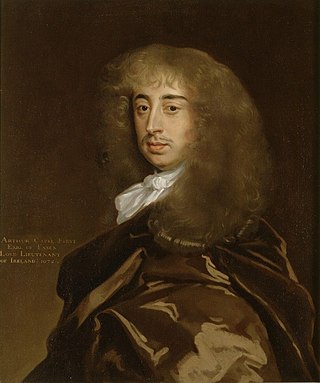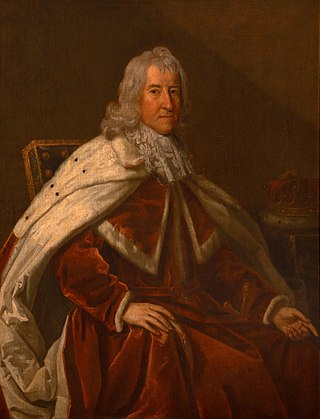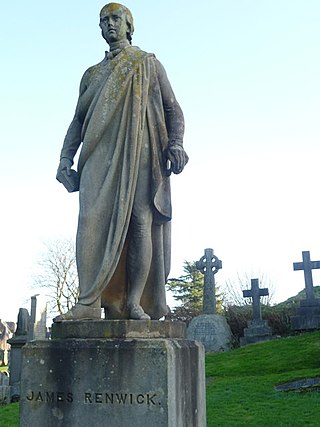Related Research Articles

Arthur Capell, 1st Earl of Essex, PC, also spelt Capel, of Cassiobury House, Watford, Hertfordshire, was an English statesman.
A constitutional convention is an informal and uncodified tradition that is followed by the institutions of a state. In some states, notably those Commonwealth of Nations states that follow the Westminster system and whose political systems derive from British constitutional law, most government functions are guided by constitutional convention rather than by a formal written constitution. In these states, actual distribution of power may be markedly different from those the formal constitutional documents describe. In particular, the formal constitution often confers wide discretionary powers on the head of state that, in practice, are used only on the advice of the head of government, and in some cases not at all.

The Cavalier Parliament of England lasted from 8 May 1661 until 24 January 1679. It was the longest English Parliament, and longer than any Great British or UK Parliament to date, enduring for nearly 18 years of the quarter-century reign of Charles II of England. Like its predecessor, the Convention Parliament, it was overwhelmingly Royalist and is also known as the Pensioner Parliament for the many pensions it granted to adherents of the King.

Anthony Ashley Cooper, 1st Earl of Shaftesbury PC FRS, 22 July 1621 to 21 January 1683, was an English politician and statesman from Dorset. He held senior political office under both the Commonwealth of England and Charles II, serving as Chancellor of the Exchequer from 1661 to 1672, and Lord Chancellor from 1672 to 1673. During the 1679 to 1681 Exclusion Crisis, he headed the movement to bar the Catholic heir, James II from the succession, often seen as the origin of the Whig party. He was also a patron of the political philosopher John Locke, with whom he collaborated with in writing the Fundamental Constitutions of Carolina in 1669.

John Robartes, 1st Earl of Radnor and Viscount Bodmin, known as The Lord Robartes between 1634 and 1679, was a Cornish politician, who fought for the Parliamentary cause during the English Civil War. He retired from public life before the trial and execution of Charles I (1649) and did not take an active part in politics until after the Restoration in 1660. During the reign of Charles II he opposed the Cavalier party. Toward the end of his life he opposed the more extreme Protestant groups, led by Anthony Ashley Cooper, 1st Earl of Shaftesbury, who refused to accept the succession of James because he was a self-declared Catholic.

George Savile, 1st Marquess of Halifax,, was an English statesman, writer, and politician who sat in the House of Commons in 1660, and in the House of Lords after he was raised to the peerage in 1668.

The governments of the Thirteen Colonies of British America developed in the 17th and 18th centuries under the influence of the British constitution. After the Thirteen Colonies had become the United States, the experience under colonial rule would inform and shape the new state constitutions and, ultimately, the United States Constitution.
Minister of the Crown is a formal constitutional term used in Commonwealth realms to describe a minister of the reigning sovereign or viceroy. The term indicates that the minister serves at His Majesty's pleasure, and advises the sovereign or viceroy on how to exercise the Crown prerogatives relating to the minister's department or ministry.

The Cabal ministry or the CABAL refers to a group of high councillors of King Charles II of England, Scotland and Ireland from 1668 to c. 1674.

The Australian Government, also known as the Commonwealth Government, is the national government of Australia, a federal parliamentary constitutional monarchy. Like other Westminster-style systems of government, the Australian Government is made up of three branches: the executive, the legislative, and the judicial.

William Russell, Lord Russell was an English politician. He was a leading member of the Country Party, forerunners of the Whigs, who during the reign of King Charles II, laid the groundwork for opposition in the House of Commons to the accession of an openly Catholic king in Charles's brother James. This ultimately resulted in Russell's execution for treason, almost two years before Charles died and James acceded to the throne.

The Killing Time was a period of conflict in Scottish history between the Presbyterian Covenanter movement, based largely in the southwest of the country, and the government forces of Kings Charles II and James VII. The period, roughly from 1679 to the Glorious Revolution of 1688, was subsequently called The Killing Time by Robert Wodrow in his The History of the Sufferings of the Church of Scotland from the Restoration to the Revolution, published in 1721–22. It is an important episode in the martyrology of the Church of Scotland.

The Privy Council of England, also known as HisMajesty's Most Honourable Privy Council, was a body of advisers to the sovereign of the Kingdom of England. Its members were often senior members of the House of Lords and the House of Commons, together with leading churchmen, judges, diplomats and military leaders.
England under Elizabeth I's reign, the Elizabethan Era, was ruled by the very structured and complicated Elizabethan government. It was divided into the national bodies, the regional bodies, the county, community bodies and the court system.
Events from the year 1679 in England.
Henry Powle was an English lawyer and politician who sat in the House of Commons at various times between 1660 and 1690, and was Speaker of the House of Commons from January 1689 to February 1690. He was also Master of the Rolls.

The Habeas Corpus Parliament, also known as the First Exclusion Parliament, was a short-lived English Parliament which assembled on 6 March 1679 during the reign of Charles II of England, the third parliament of the King's reign. It is named after the Habeas Corpus Act, which it enacted in May 1679.

The Exclusion Bill Parliament was a Parliament of England during the reign of Charles II of England, named after the long saga of the Exclusion Bill. Summoned on 24 July 1679, but prorogued by the king so that it did not assemble until 21 October 1680, it was dissolved three months later on 18 January 1680/81.

Sir Thomas Pilkington was an English merchant, politician and Lord Mayor of London.
In United Kingdom constitutional law, prorogation is an act usually used to mark the end of a parliamentary session. Part of the royal prerogative, it is the name given to the period between the end of a session of the UK Parliament and the State Opening of Parliament that begins the next session. The average length of prorogation since 2000 is approximately 18 days. The parliamentary session may also be prorogued before Parliament is dissolved. The power to prorogue Parliament belongs to the monarch, on the advice of the Privy Council. Like all prerogative powers, it is not left to the personal discretion of the monarch but is to be exercised, on the advice of the prime minister, according to law. Almost all Bills that have not been enacted before dissolution are lost.
References
- 1 2 3 Ogg, Frederic Austin (1913). The Governments of Europe. Macmillan.
- 1 2 Ray, Perley Orman (1931). Major European Governments. Ginn and Company. OCLC 2842078.
- ↑ Spencer, Henry Russell (1936). Government and Politics Abroad. H. Holt and Company.
- ↑ Clarke, John Joseph (1958). Outline of Central Government: Including the Judicial System of England. Pitman.